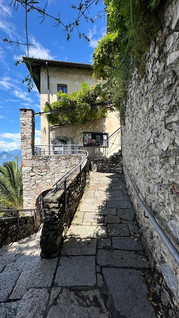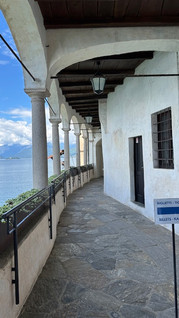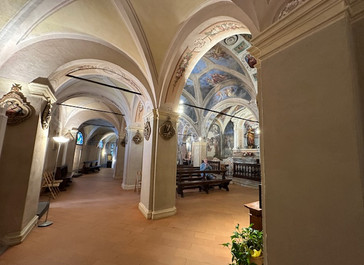Santa Caterina Hermitage – Eremo di Santa Caterina
- Maria Scuor
- Jun 7
- 8 min read
Scorri a basso per l’italiano
We took a ½ hour drive to the other side of Lago Maggiore to explore the Santa Caterina del Sasso Hermitage. It is located on the cliffs of the lake in the town of Leggiuno in Varese. We got to the large parking lot and walked to the square where there is a restaurant and reception to purchase tickets to the hermitage. We paid 5 euros for our tickets as well as 3 euros for a digital audio guide and 2 euros for the elevator ride back up. If we were healthy, we would have walked up the 268 steps it takes to get down to the hermitage but great there is an elevator option. You can also take a boat from Stresa to the hermitages boat dock.
According to tradition or beliefs, the complex originated in 1170 when Alberto Besonzzi from Arolo who was a merchant and escaped being shipwrecked. While he was crossing the lake, he vowed to Saint Catherine of Alexandria that he would retire for the rest of his life in prayer and solitude in a cave on that stretch of the coast if he was saved. It was on this site he built the chapel in 1195 to honour the saint, for thanksgiving for the liberation from the plague. Later the chapel was preserved inside the church then blessed and ultimately Alberto’s remains rest inside the church after his death on September 3rd 1205.
The monastic complex came to be between the 13th and 14th centuries. Nobles from Ispra constructed two churches, one dedicated to Santa Maria Nova in 1270 as an ex-voto for having been saved from wolves raiding the livestock and the second church dedicated to San Nicolao in 1301. The third church dedicated to Santa Caterina dates back to 1308. Consecration of Santa Maria and San Nicolao is recorded in 1339. And restoration of joining all three churches into one building happened in the 16th century.
At the beginning of the 18th century five giant rocks fell on the church and got entangled in the chapel vault above Alberto’s remains. This was seen as a miracle and therefore the chapel was named the “Chapel of the Rocks”. The rocks finally fell to earth in 1910, causing no damage. But the hole above Alberto’s remains depicts the history of the rocks. A landslide in the 19th century took away part of the 1574 path that lead to the church; therefore, a long staircase was built which allows us to reach the complex from the opposite side of the church.
The bell tower that overlooks the lake is in Romanesque style and dates back to the 14th century. It is 12 metres (39 ft) high and originally built as the bell tower for San Nicolao church and was directly connected through a door. As part of the 16th century amalgamation of the three churches the entrance was placed in the Renaissance portico. The bell tower has an opening on each side, except for the one facing north as it was walled up. The presence of a central support for the architrave gives it an appearance of mullioned windows.
The ancient convent is made up of various buildings. The southern convent was built a the end of the 13th century and is a two-story building that houses the chapter house and preserves frescoes from the 14th century. Including a Crucifixion with Saints Catherine and Ambrose and a Healing of a horse by Saint Eligius, near Saint Anthony that dates back to 1439.
The courtyard between the two convents, has a very cool yet primitive wine and olive press from 1759. And the Conventino, a building between the chapter house and church, dates back to 13th – 14th century and housed the kitchen, the refectory and the cells.
This complex has been considered a national monument since 1914, and on June 4th, 1970 the ownership passed to the provincial administration of Varese governed by the Dominican community. This is when major restoration work began with consolidation and stabilization work on the rocks, both above the buildings and at the base. The sanctuary was saved and reopened on September 10th 1986, with Cardinal Martini consecrating the new Baveno stone altar. From 1996 to 2018 the sanctuary was governed by the Benedictine oblates and since 2019 it has been taken care of by the Franciscan fraternity of Bethany.
The façade, built in 1508, has a Renaissance portico with four round arches and three columns that are made of Angera stone and has leaf-shaped capitals. The portico preserves what remains of frescoes, including images of Saints Peter, Nicholas, Peter of Verona, Lucy, Mary Magdalene and Caterina. There are also other scenes from the life of Saint Caterina in the upper spaces between the arches.
Inside the church there are five spaces; the area of the high altar; the chapels of San Nicolao, Santa Caterina, and Santa Maria Nova and the chapel where the remains of the blessed Alberto Besozzi were placed in a glass case. The body visible in the case is a wooden statue depicting the skeleton of the blessed and his remains are preserved in an urn hidden inside the cushion.
There are several valuable works of art in the church that date back from 1438 through to the 18th century. These include many beautiful frescoes, stained glass windows, wooden statues, an altarpiece and a Neapolitan organ by Domenico Antonio Rossi in 1783.
In 2010, the Province of Varese complete the Santa Caterina del Sasso’s elevator. It is an engineering marvel that travels down carved rock, with a shaft 6 metres (19.5 ft) in diameter and 51 metres (167 ft) long. The elevator holds 12 passengers and when you come out at the hermitage level the 45 metre (147.6 ft) horizontal tunnels provide amazing views of the lake as you exit it. At the same time the elevator was built, the whole rock face was stabilized and the foundations were consolidated.
Photos of exterior - Foto dell'esterno


Photos of interior - Foto dell'interno
Photos of Chapter House - Foto della sala capitolare
Photos of elevator build - Foto del costruzione dell'ascensore
Eremo di Santa Caterina
Abbiamo fatto un viaggio di 1/2 ora dall'altra parte del Lago Maggiore per esplorare il Eremo di Santa Caterina del Sasso. Si trova sulle falesie del lago nel comune di Leggiuno in provincia di Varese. Siamo arrivati al grande parcheggio e siamo andati a piedi fino alla piazza dove c'è un ristorante e la reception per acquistare i biglietti per il eremo. Abbiamo pagato 5 euro per i nostri biglietti, 3 euro per un'audioguida digitale e 2 euro per il viaggio di ritorno in ascensore. Se fossimo stati in salute, avremmo salito i 268 gradini necessari per scendere al eremo, ma fantastico c'è un'opzione di ascensore. È inoltre possibile prendere un battello da Stresa al molo del eremo.
Secondo la tradizione o le credenze, il complesso ebbe origine nel 1170 quando Alberto Besonzzi da Arolo, che era un mercante, scampato al naufragio. Mentre attraversava il lago, fece voto a Santa Caterina d'Alessandria che si sarebbe ritirato per il resto della sua vita in preghiera e solitudine in una grotta in quel tratto di costa, se si fosse salvato. Fu su questo sito che costruì la cappella nel 1195 per onorare il santo, come ringraziamento per la liberazione dalla peste. In seguito la cappella fu conservata all'interno della chiesa, poi benedetta e infine le spoglie di Alberto riposano all'interno della chiesa dopo la sua morte, avvenuta il 3 settembre 1205.
Il complesso monastico si formò tra il XIII e il XIV secolo. I nobili ispresi costruirono due chiese, una dedicata a Santa Maria Nova nel 1270 come ex-voto per essere stata salvata dai lupi che razziavano il bestiame e la seconda chiesa dedicata a San Nicolao nel 1301. La terza chiesa dedicata a Santa Caterina risale al 1308. La consacrazione di Santa Maria e San Nicolao è registrata nel 1339. E il restauro di unire tutte e tre le chiese in un unico edificio avvenne nel XVI secolo.
All'inizio del XVIII secolo cinque gigantesche rocce caddero sulla chiesa e rimasero impigliate nella volta della cappella sopra le spoglie di Alberto. Questo fu visto come un miracolo e quindi la cappella fu chiamata "Cappella delle Rocce". Le rocce caddero infine a terra nel 1910, senza causare danni. Ma il buco sopra i resti di Alberto raffigura la storia delle rocce. Una frana nel XIX secolo portò via parte del sentiero del 1574 che portava alla chiesa; Pertanto, è stata realizzata una lunga scalinata che ci permette di raggiungere il complesso dal lato opposto della chiesa.
Il campanile che si affaccia sul lago è in stile romanico e risale al XIV secolo. È alto 12 metri ed è stato originariamente costruito come campanile della chiesa di San Nicolao ed era collegato direttamente attraverso una porta. Nell'ambito della fusione cinquecentesca delle tre chiese, l'ingresso fu collocato nel portico rinascimentale. Il campanile presenta un'apertura per lato, ad eccezione di quella rivolta a nord in quanto murata. La presenza di un supporto centrale per l'architrave gli conferisce l'aspetto di bifore.
L'antico convento è composto da vari edifici. Il convento meridionale fu costruito alla fine del XIII secolo ed è un edificio a due piani che ospita la sala capitolare e conserva affreschi del XIV secolo. Comprende una Crocifissione con i Santi Caterina e Ambrogio e una Guarigione di un cavallo di Sant'Eligio, vicino a Sant'Antonio, che risale al 1439.
Il cortile tra i due conventi, ha un frantoio molto fresco ma primitivo del 1759. E il Conventino, un edificio tra la sala capitolare e la chiesa, risale al XIII-XIV secolo e ospitava la cucina, il refettorio e le celle.
Questo complesso è considerato monumento nazionale dal 1914 e il 4 giugno 1970 la proprietà passò all'amministrazione provinciale di Varese governata dalla comunità domenicana. Da qui sono iniziati gli importanti lavori di restauro con lavori di consolidamento e stabilizzazione delle rocce, sia sopra gli edifici che alla base. Il santuario fu salvato e riaperto il 10 settembre 1986, con la consacrazione del nuovo altare in pietra di Baveno da parte del cardinale Martini. Dal 1996 al 2018 il santuario è stato governato dagli oblati benedettini e dal 2019 è curato dalla fraternità francescana di Betania.
La facciata, realizzata nel 1508, presenta un portico rinascimentale con quattro archi a tutto sesto e tre colonne che sono in pietra di Angera e hanno capitelli a forma di foglia. Il portico conserva ciò che resta degli affreschi, tra cui le immagini dei Santi Pietro, Nicola, Pietro da Verona, Lucia, Maria Maddalena e Caterina. Ci sono anche altre scene della vita di Santa Caterina negli spazi superiori tra gli archi.
All'interno della chiesa ci sono cinque spazi; l'area dell'altare maggiore; le cappelle di San Nicolao, Santa Caterina e Santa Maria Nova e la cappella dove furono deposte in una teca di vetro le spoglie del beato Alberto Besozzi. Il corpo visibile nella teca è una statua lignea raffigurante lo scheletro del beato e le sue spoglie sono conservate in un'urna nascosta all'interno del cuscino.
Nella chiesa si trovano diverse opere d'arte di pregio che risalgono al 1438 fino al XVIII secolo. Tra questi spiccano i bellissimi affreschi, le vetrate, le statue lignee, una pala d'altare e un organo napoletano realizzato da Domenico Antonio Rossi nel 1783.
Nel 2010 la Provincia di Varese ha completato l'ascensore di Santa Caterina del Sasso. Si tratta di una meraviglia dell'ingegneria che viaggia lungo la roccia scolpita, con un pozzo di 6 metri di diametro e 51 metri di lunghezza. L'ascensore può contenere 12 passeggeri e quando si esce al livello del eremo, i tunnel orizzontali di 45 metri offrono una vista mozzafiato del lago all'uscita. Contemporaneamente è stato costruito l'ascensore, è stata stabilizzata l'intera parete rocciosa e sono state consolidate le fondamenta.





























































































































































Comments